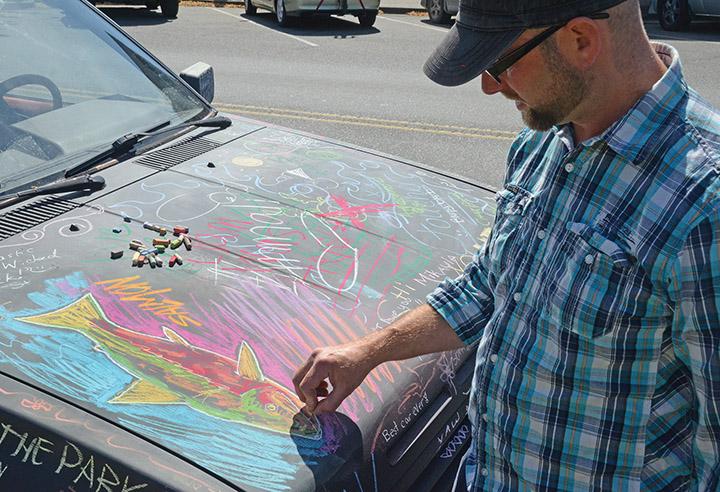One man’s path to a bigger, more lively and more interactive art experience
There’s a 1990 Nissan Pathfinder driving around our region with a matte black finish. A transparent pamphlet display unit hangs from the rear passenger side window. That pamphlet holder is full of chalk, and it’s clear what you’re being invited to do, because others already have.
It beckons to you. And you go to it.
You follow the instructions of the vinyl signage on the vehicle’s windows asking you to “Chalk My Ride.”
Maybe you write a message. Maybe you draw something. It doesn’t matter to the owner. It’s all about engaging with art in whatever way you want. He’s just supplying the “canvas.”
That Pathfinder belongs to mural artist Alex Witcombe. Witcombe doesn’t just make art. He lives it.
“I’ve always been an artist,” he says. “When I was a kid I’d have sketchbook after sketchbook full of drawings of whatever I was into right then.”
And so when it came time to decide a career path, he decided to keep going in what he loved.
“Looking back on it, I probably should have taken a trade of some kind,” he laughs, a gentle poke at both himself and the “starving artist” stereotype that turns out to be somewhat accurate.
After completing North Island College’s Fine Arts Diploma program, Witcombe went on to take a Bachelor of Fine Arts through the Emily Carr University of Art and Design’s satellite program campus in Courtenay. Then he threw himself out into the world and started looking for work.
It’s been a tough slog. Becoming an artist isn’t a, “graduate and then go take your resumé around,” kind of endeavour.
“It did take a while for me to transition into art as a full-time job,” he says. “You need constant focus and you need to really get out there and meet people – getting your name out there is the big thing.”
He’s got some regular work – he goes around the country painting murals at Laser Quest facilities when they need to be redone – but most of the time his art life is a cycle of, “create proposal, submit proposal, wait for response, repeat.”
Occasionally there’s a “create mural” phase in there, but not as often as there isn’t.
“I’ve spent 30 hours on a proposal and not gotten any work out of it,” Witcombe says. “I would say I spend as much time making proposals as I do actually making art. It’s probably 50/50,” he laughs.
“The most frustrating thing was when there just wasn’t money there (during the recession in the late 2000s). I’d be doing a lot of mural proposals and putting in a lot of time, and sometimes it just turns out that there’s no money for the work.”
Murals are big and time-consuming, after all, and through the economic downturn the world took not that long ago, Witcombe says, it was hard to convince people to spend the money on things like art.
Ken Blackburn, Executive Director of the Campbell River Arts Council, sees significant value in Witcombe’s contributions to the community, however, and thinks his career will be taking off soon, especially with implemented initiatives like Campbell River’s Downtown Façade Improvement Project – which provides matching grants of up to $10,000 to business owners who want to make improvements to their buildings – giving incentive to businesses to spruce up their walls.
“I think Alex’s work fits well within a discussion of how the arts can contribute to overall community development,” Blackburn says. “The use of public murals, or banners – or generally ‘art in public spaces’ – activate urban space and bring a sense of vitality to the experience of a downtown core. His ability to work creatively and imaginatively in a number of styles and themes is quite remarkable, whether addressing historic subject matter, aquatic life, fantasy, portraiture, landscape, you name it, Alex can produce it and maintain a high sense of aesthetic appeal.”
That fits the bill for the Façade Improvement Project, which according to Mayor Andy Adams, “is intended to make city streets more appealing, inviting and interesting places to walk and shop.”
“I think (Witcombe’s) greatest strength is being able to have popular appeal in a public space at the same time as keeping the artistic integrity necessary to also be a strong work of art,” Blackburn says. “His imagery is great for the downtown business climate and adds a positive sense of social dynamism to Campbell River. Art can play a huge factor in fostering progressive economic, social or cultural development within a city, and Alex Witcombe’s work is a great example of how this is done.”
He’s already done a few things to brighten up Campbell River’s downtown.
His work was chosen for a banner project last year, when Daybreak Rotary chose his design to help Jim Creighton, manager of Spirit Square, spruce up the area.
He also created the entrance wall to the new Volunteer Campbell River facility on Alder Street, and was involved in the mural work on Mussels and More in Campbellton.
So what’s next for Witcombe?
“I’m just going to keep at it. I’ve got a few proposals in for projects that I’m hoping to hear good news about,” he says, hinting at the possibility of at least two upcoming major projects in the downtown core of Campbell River.
But until he hears back on those, he’ll just keep putting himself out there and showing up at events with his Pathfinder and his chalk, engaging the community with art.
Because it’s what he loves, and it’s important to him to share that love with whoever he can, however he can.
Check out some of Witcombe’s work at flywheel-studios.com and watch for more of it to be going up around town.
